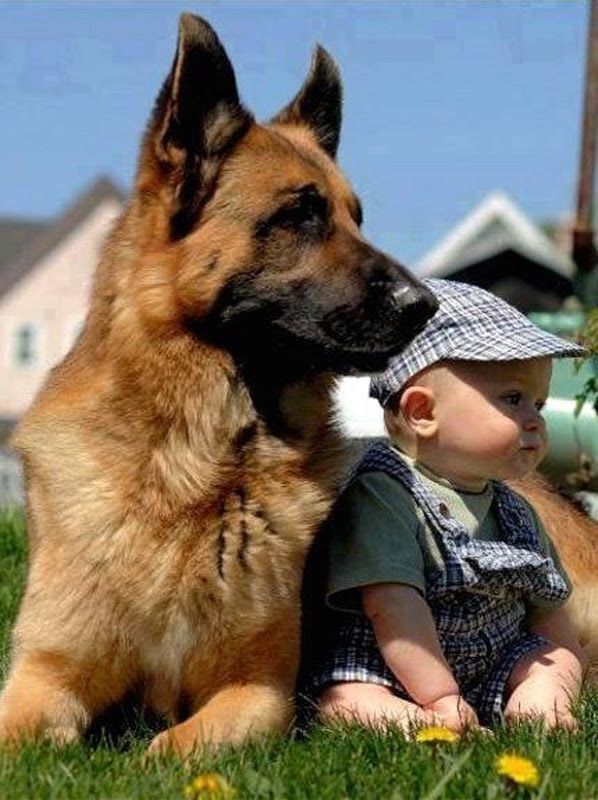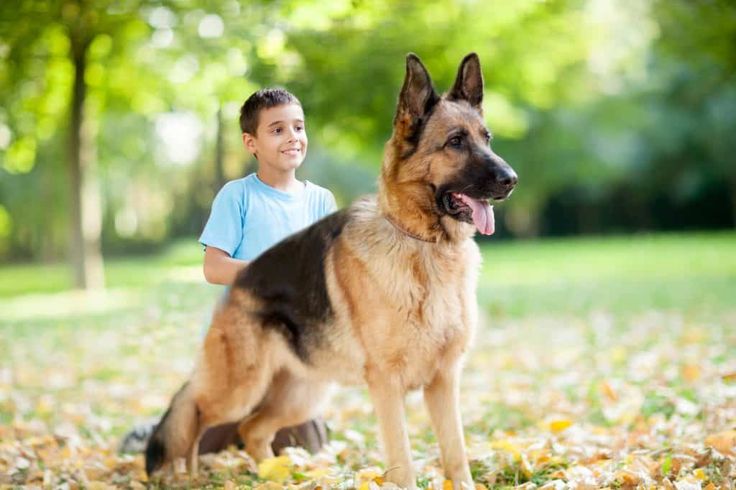Introducing kids to a German Shepherd involves a delicate balance of safety, understanding, and gradual familiarity. For families, especially those with first-time GSD owners, ensuring a smooth transition is key.
Start by familiarizing yourself with the loyal nature of the German Shepherd breed. These dogs, while known for their guarding instincts, can be trusted companions for children. However, understanding their behavior and the importance of training is crucial.
Creating safe spaces for interaction is equally important. Designate areas where both the German Shepherd and kids can engage comfortably and safely. Teaching children how to respectfully approach and interact with the dog is vital. It’s not just about the kids adjusting; the German Shepherd needs time to adapt as well.
Encourage bonding between the kids and the German Shepherd. Answering their questions about the breed helps build familiarity and trust. In my own experience, gradual introductions and consistent training sessions made a significant difference. Our German Shepherd became an integral part of our family, fostering loyalty and companionship that enriched both our lives and the dog’s.
German Shepherds’ Behavior with Kids
When introducing a German Shepherd to kids, it’s crucial to approach the initial meeting with care and consideration. These dogs, known for their steadfast nature, can be wonderfully gentle with children. However, their size can be intimidating, especially for little ones.
Our journey with a German Shepherd and our kids began with a strong emphasis on socialization and training, ensuring our dog became a beloved family pet. We took deliberate steps to create a safe environment, setting clear boundaries for both the children and the dog.
Our priority was teaching our kids to respect our dog’s space, understanding that even the wag of their tail could accidentally startle or hurt if not handled gently. Discipline was part of the equation, but it was always done in a way that emphasized understanding our dog’s needs. This approach helped foster a harmonious atmosphere, where our German Shepherd and our children coexisted in a way that was both enriching and safe for everyone involved.
Tips for Introducing Your German Shepherd to Your kids
The initial introduction might cause you to become nervous, thinking about how it might go. It’s important, though, that you maintain the lead, reward positive behavior, and take it all in small steps. A few tips for introducing your German Shepherd to your baby include:
Prepare Your Puppy for the Moment
Start by taking your puppy for a long walk. This step aids in burning off excess energy, encouraging a more relaxed state. After a few days apart, it’s wise to wait until your puppy calms down before the introduction.
Familiarizing your puppy with your baby’s scent beforehand can be beneficial. This helps create a more familiar environment, setting the stage for a smoother interaction.
When the time comes for the introduction, it’s crucial to supervise closely. Maintaining a calm and positive atmosphere during this interaction is key to ensuring a comfortable meeting between your puppy and your baby.
Pay Attention to Your Emotions
When inviting a German Shepherd into your family with kids, managing your emotions becomes vital. Maintain a composed and relaxed demeanor as it significantly impacts the introduction process.
Creating a serene setting is crucial; it might be challenging, but ensuring a calm atmosphere allows both the dog and the child to find their balance.
Patience is the name of the game. Let everyone take their time to rest and wait for the opportune moment. These dogs are perceptive and will approach when they sense readiness.
Understanding the influence of hormones on a puppy’s behavior is crucial. Start with low-energy interactions and gradually expose them to different scenarios, always prioritizing a relaxed environment.
Based on personal experience, introducing my German Shepherd to children required a steady approach. Keeping calm and relaxed throughout facilitated a natural and positive connection.
Start with Small Steps
When introducing kids to a German Shepherd, begin by calmly meeting the dog from a safe distance. Encourage a quiet environment to prevent the dog from getting overly excited or barking excessively.
As the dog stays calm, allow the children to approach slowly. Let them extend a hand for the dog to sniff while maintaining a safe distance. Patience is key; if the dog seems uneasy, it’s okay to retry the interaction later.
Gradually build trust by taking a long walk together. This familiarizes both the puppy and the baby with each other, fostering a comfortable environment.
Supervise the interaction as an adult to ensure safety. With each encounter, the German Shepherd learns to invite the children into its space.
Use Rewards to Reinforce Positive Behavior
When introducing a puppy to a baby, maintain a safe distance and offer positive associations by allowing them to sniff each other calmly. Reinforce the positive behaviors with treats and a new toy to establish calm and rewarding interactions, creating handy associations between the two, ensuring a harmonious environment.
Use Playtime to Help Your GSD Bond With Your Kids
German Shepherd dogs are a wonderful breed for families with children, as they form a strong bond and enjoy playtime. It’s crucial to teach both kids and GSDs how to play safely through interactive games like fetch and tugging with a toy. Setting boundaries ensures fun game time without the risk of injury. When supervised and guided, these friendly yet active pets create positive experiences for the whole family, keeping everyone engaged and fit while fostering a bonded, healthy atmosphere. Their intuitive nature makes them cautious around babies, yet they’re not overly protective, allowing for an involved and safe environment.
When you find out you’re going to have a baby.
Taking a German Shepherd to a basic obedience class can address behavior issues like excessive jumping to greet at the door. Their strong and large build might be a problem, especially around small children or during a pregnancy; however, with a calm approach from the instructor, these dogs can learn to control their behavior. Exposure to babies, especially their sudden movements or shrieking, helps them predict the baby’s next move and not react impulsively. It’s crucial to keep a distance initially and gradually join walks with friends and children so they get used to the behavior around small children in parks, ensuring a more relaxed interaction.
Three months before your scheduled deadline
When a German Shepherd joins a family with newborns, it’s vital to prepare. Use baby shampoo and powder scents to familiarize the dog with the baby’s smell. Betsy Saul suggests using a stroller or leash to practice walking alongside the baby’s wheels for control. This smart dog breed learns tricks easily, establishing a relationship takes time and effort. Getting used to a furry friend around is important; train them to investigate without being dangerous. It’s well worth the effort to establish a routine where they sniff but listen to your commands, keeping everyone safe.
One month before your scheduled deadline
At 3 a.m., the German Shepherd, a beloved pet, was getting ready to deliver at the hospital. Gone for a couple of days, her friends and pet sitters were enlisted to find her. Later, someone found her in the park, taking care of a newborn girl. She likes feeding and walking the baby, knowing her owners can count on her.
Two weeks before your scheduled deadline
Scheduled cesarean sections or inductions provide an exact date for birth, easing the uncertainty of time. If emotions confuse you, staying calm is key. Sit down with your caregiver to discuss any doubts or concerns, ensuring a thousand details are addressed. For those with pets, especially a dog like a GSD, planning for their individual servings and arranging for their care during the hospital stay makes things easier for both you and them.
Remember, starting with the right information and support will help you navigate this important deadline without feeling overwhelmed. Don’t hesitate to jot down important phone numbers and take proactive steps towards a smoother experience.
While you’re in the hospital
After resting following the birth of their baby’s arrival, the family members were excited yet a bit confused as they brought the little one home. Amidst the collection of tiny bodysuits and soft blankets, the German Shepherd sniffed around, getting used to the new smell in the house. Everyone was eager to embrace this new family member, creating an atmosphere of anticipation and warmth.
When you enter the house for the first time after giving birth
Taking a long walk with my German Shepherd has become an important part of our routine since the beginning. While tending to my newborn, my partner and I ensure the baby gets their nap while I breastfeed. Upon a visitor’s arrival, our dog is always excited to sniff and be greeted, yet equally acquainted with the need to sit down and behave lightly. Treating our furry friend with attention and a treat after the walk helps release their excess energy, allowing them to curl up for a nap in the house. Balancing responsibilities for both the baby and our dog remains exciting and equally fulfilling.
Long-Term Success: What to Do After Your Introduction
To ensure safety during the initial introduction of a new puppy, take gradual steps to ease the transition. Here are some tips to ensure an easy and safe introduction process.
Supervision Is Always Important
Supervision is important when your puppy and baby are together. Never leave them alone in a room without a close eye. Puppies may nip or invade their personal space inadvertently.
Maintain Routines with Your Puppy
German Shepherd puppies are working dogs that require daily exercise to stay happy and healthy. Maintaining a routine of walks and training is important, albeit difficult for new parents. Chances are, normal routines may change in the weeks leading up to the due date. However, making small changes and continuing routines post-delivery is crucial until the puppies closely resemble their usual selves, so it’s especially important to maintain routines with your puppy—it’s best for their well-being.
Teach Baby about Boundaries
In a year, a baby starts to grow, transitioning from crawling to moving with the aid of a furry friend like a playful puppy, often found tugging at its tails. Creating a safe crawling zone is essential to help the little one learn, filled with enticing toys and enough space to explore. Introducing a patient German Shepherd can prevent territorial issues by sharing food and teaching gentle interactions.
Kids and German Shepherds: Safety Tips

Understanding Body Language: Introducing kids to German Shepherds involves understanding the dog’s responses. Their high energy and intelligence mean they might react swiftly to sudden movements or high-pitched noises, often seen as over-excitement or rapid responses.
Managing Play and Interaction: While these dogs are devoted and energetic, misinterpreted behaviors can cause issues. Nipping or loud barking might be playful rather than intimidating. It’s crucial to understand these actions to avoid misunderstandings.
Setting Boundaries and Supervision: Teaching kids to respect boundaries and comprehend the dog’s temperament is an adult’s responsibility. Supervision is vital, especially with younger kids and friendly Shepherds. Even seemingly harmless actions like licking faces might lead to accidents.
Ensuring Safe Interaction: Preventing misunderstandings is key. For instance, a GSD’s jumping might be playful but distressing for smaller children. Adult guidance during greetings or interactions is essential to prevent accidental knockdowns.
In summary, ensuring a safe environment for both German Shepherds and children involves understanding cues, managing interactions, setting boundaries, and constant supervision. It’s crucial to educate both sides about safety to ensure a harmonious coexistence.
Conclusion
Kids to a German Shepherd is a multifaceted process, demanding patience, understanding, and proactive steps for a harmonious relationship. Safety and gradual familiarity are pivotal, whether you’re welcoming a new puppy or an adult Shepherd into your family.
Understanding the breed’s loyal yet guarded nature is the cornerstone, emphasizing the importance of training and creating safe interaction spaces. Teaching children to respectfully engage with the dog and supervising their interactions fosters trust and safety for everyone involved.
Reflecting on personal experiences, a balanced approach of gradual introductions, consistent training, and involving the whole family facilitated a rewarding companionship between our German Shepherd and our children. Ultimately, whether choosing a puppy or an adult Shepherd, the decision should align with the family’s dynamics and capacity to invest time and effort into nurturing a fulfilling relationship.
FAQs
Do German Shepherds get along with kids?
Suitability. Although they have a reputation for being a tough dog, German Shepherds (particularly females) are generally sweet-natured and good with children.
How do I get my German Shepherd ready for a baby?
To start, make the nursery off-limits, especially for the first few months. Also, don’t allow your German Shepherd puppy to sleep, climb or jump up on any baby furniture. After the baby arrives, but before he has come home, bring a small item of his clothing home with you. (A burp cloth or nursery hat works great!)
How do you introduce a new German Shepherd?
Follow these steps for introducing dogs to each other.
- Find a Neutral Spot to Make Introductions.
- Watch for Positive Dog Body Language.
- Walk the Dogs Together.
- Allow the Dogs to Interact Off-Leash.
- Monitor Mealtimes.
- Give Each Dog Their Own Bed.
- Introduce Toys Slowly.
- Separate the Dogs When You’re Away.
What is the best type of German Shepherd for a family?
The West-German Working Line is widely considered the most popular type of German Shepherd. They’re medium-sized dogs, and they have short hair that’s easy to maintain. This breed makes for excellent pets because they tend to stay calm around new people and animals.


